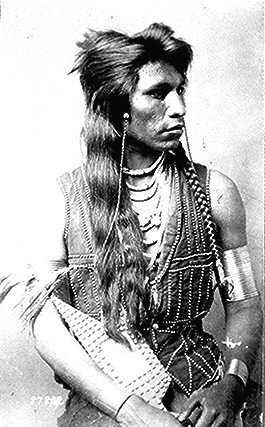Shoshone
Shoshone or Shoshoni are a Native American people who traditionally inhabited the territory in the western United States, primarily within the present-day states of Idaho, Nevada, and Utah. The Shoshone are part of the larger Numic-speaking group of Great Basin Indians, which also includes the Comanche, Paiute, and Ute peoples. They have historically been divided into four main cultural-geographic groups: the Western Shoshone, Northern Shoshone, Eastern Shoshone, and Goshute.
History[edit | edit source]
The Shoshone people have a long and rich history that dates back thousands of years. Their traditional lands stretched from the Great Basin to the northern Rockies. The Shoshone were known for their nomadic lifestyle, which was heavily influenced by the seasonal migration of wildlife, particularly the buffalo, which was a critical resource for food, clothing, and shelter.
During the 18th and 19th centuries, the Shoshone experienced significant changes due to European and American expansion. The arrival of Lewis and Clark in the early 1800s marked the beginning of increased contact with European Americans. The Shoshone played a crucial role in the expedition, notably through the assistance of Sacagawea, a Lemhi Shoshone woman who helped guide and interpret for the explorers.
The discovery of gold and other minerals in Shoshone territory in the mid-19th century led to increased conflict and displacement. The Treaty of Ruby Valley (1863) was one such agreement intended to ensure peace between the Shoshone and the United States, but it also led to significant loss of land and resources for the Shoshone people.
Culture[edit | edit source]
Shoshone culture is deeply rooted in their relationship with the land and the natural resources available to them. They were adept at utilizing the diverse environments they inhabited, from hunting buffalo on the plains to fishing in the rivers of the Great Basin. The Shoshone also gathered a wide variety of plants for food, medicine, and crafting materials.
Traditional Shoshone society was organized into bands, which were small, nomadic groups that moved within specific territories to exploit seasonal food resources. Social and political organization was relatively informal, with leadership roles often based on personal qualities such as wisdom, bravery, and generosity.
Language[edit | edit source]
The Shoshone language is part of the Uto-Aztecan language family, which is one of the largest Native American language families in terms of geographical spread and number of speakers. The language is still spoken today, though it is considered endangered. Efforts are being made to revitalize the language through educational programs and the use of modern technology.
Contemporary Issues[edit | edit source]
Today, the Shoshone people continue to face challenges related to the preservation of their culture, land rights, and legal battles over treaties and agreements made with the United States government. Despite these challenges, the Shoshone strive to maintain their cultural heritage and traditions, while also adapting to the modern world.
This article is a ethnic-group stub. You can help WikiMD by expanding it!
Search WikiMD
Ad.Tired of being Overweight? Try W8MD's physician weight loss program.
Semaglutide (Ozempic / Wegovy and Tirzepatide (Mounjaro / Zepbound) available.
Advertise on WikiMD
|
WikiMD's Wellness Encyclopedia |
| Let Food Be Thy Medicine Medicine Thy Food - Hippocrates |
Translate this page: - East Asian
中文,
日本,
한국어,
South Asian
हिन्दी,
தமிழ்,
తెలుగు,
Urdu,
ಕನ್ನಡ,
Southeast Asian
Indonesian,
Vietnamese,
Thai,
မြန်မာဘာသာ,
বাংলা
European
español,
Deutsch,
français,
Greek,
português do Brasil,
polski,
română,
русский,
Nederlands,
norsk,
svenska,
suomi,
Italian
Middle Eastern & African
عربى,
Turkish,
Persian,
Hebrew,
Afrikaans,
isiZulu,
Kiswahili,
Other
Bulgarian,
Hungarian,
Czech,
Swedish,
മലയാളം,
मराठी,
ਪੰਜਾਬੀ,
ગુજરાતી,
Portuguese,
Ukrainian
Medical Disclaimer: WikiMD is not a substitute for professional medical advice. The information on WikiMD is provided as an information resource only, may be incorrect, outdated or misleading, and is not to be used or relied on for any diagnostic or treatment purposes. Please consult your health care provider before making any healthcare decisions or for guidance about a specific medical condition. WikiMD expressly disclaims responsibility, and shall have no liability, for any damages, loss, injury, or liability whatsoever suffered as a result of your reliance on the information contained in this site. By visiting this site you agree to the foregoing terms and conditions, which may from time to time be changed or supplemented by WikiMD. If you do not agree to the foregoing terms and conditions, you should not enter or use this site. See full disclaimer.
Credits:Most images are courtesy of Wikimedia commons, and templates, categories Wikipedia, licensed under CC BY SA or similar.
Contributors: Prab R. Tumpati, MD






